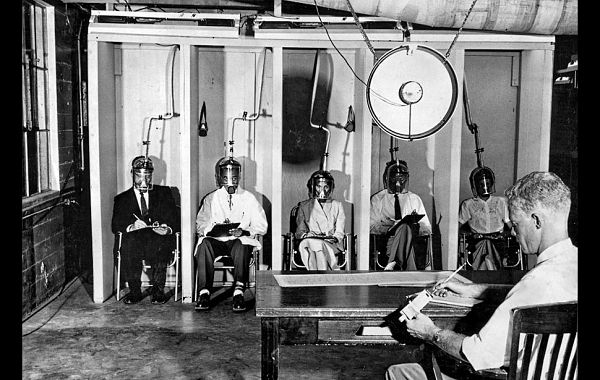 International Debate
International Debate Federal ‘Common Rule’ on Human Study Ethics Changing

Informed consent? It’s 1956, and chemical engineer Edward Liston of Stanford Research Institute checks on five subjects in smog chamber breathing reconstituted smog, noting their reactions on pads.
The U.S. Department of Health and Human Services today released draft guidelines for the ethical treatment of human beings in research conducted or paid for by the government.
The draft, four years in the making, centers on updating the “Common Rule” as the regulations – specifically Subpart A of Titles 45 and 46 of the Code of Federal Regulations — are known. In the United States, the first federal regulations designed to protect human subjects appeared in 1974, and those rules have been revised twice, most recently in 1991. The new standards are ostensibly for the federal government (including the military and intelligence agencies) but assumed to apply more universally across the research landscape domestically and even internationally.
The feds are now opening a 90-day review period for the new language, alongside questions posed to the public about specific provisions (e.g. what do you think about the proposed differences between the criteria for waiving informed consent for the research use of biospecimens versus identifiable information). The Office of Human Research Protections is sponsoring several webinars to explain the changes and a town hall will take place next month in Washington, D.C.
To Comment
To view the entire proposed rule, and to learn how to make comments on its, CLICK HERE
Given that social and behavioral science is, after all, the study of people, guidance about the best way to treat people in experiments or during research is of paramount interest to practitioners. And so the community weighed in as soon as the Department of Health and Human Services began the updating process in 2011; that effort culminated in both a 73-page white paper from 22 research organizations and a consensus report from the National Research Council offer their take on the proposed rule and how it might be amended. (Here’s an archived 2013 webinar on the NRC deliberations.) The key to their feedback was to ensure that the level of intrusion into research was proportional to the level of risk to the human subjects.
While human experimentation may draw up horrid images of medical research gone rogue (sometimes under the cover of national security), social and behavioral researchers have had their glaring transgressions and made questionable decisions, with and without institutional review. The Milgram and Stanford experiments, for example, pushed the idea of social science ethics into the public view (albeit in garbled form). And it’s not just studies from the bad ol’ days. As Australian academic Mark Israel has cataloged, “Social scientists were co-opted into American intelligence and military operations in Iraq and Afghanistan. Political scientists at Stanford University and Dartmouth College involved in experimentation on voter participation may have disrupted judicial elections in Montana. Harvard sociologists studying Facebook failed to protect the anonymity of their students.”
The need to update the Common Rule has been recognized for some time, and the research terrain evolved but the guidance didn’t.
“Since the Common Rule was promulgated,” reads the executive summary of the proposed language, “the volume and landscape of research involving human subjects have changed considerably. Research with human subjects has grown in scale and become more diverse. Examples of developments include: An expansion in the number and type of clinical trials, as well as observational studies and cohort studies; a diversification of the types of social and behavioral research being used in human subjects research; increased use of sophisticated analytic techniques for use with human biospecimens; and the growing use of electronic health data and other digital records to enable very large data sets to be analyzed and combined in novel ways.”
In addition, the government itself acknowledged that social and behavioral science needed to be dealt with much more explicitly that had previous incarnations of the guidelines; this iteration was expressly designed to “more thoroughly addresses behavioral and social science research perspectives and the broader types of research conducted or otherwise supported by the other Common Rule agencies.”
And there are differences between what’s necessary for a medical study and, say, a psychological one. For example, the privacy-protecting Health Insurance Portability and Accountability Act standards “are not appropriate for use in all types of research studies, especially much social and behavioral science research,” noted the white paper from the research organizations. “When data are collected for research, regardless of research type, the organizational settings, ethics codes, and uses to which data are put will differ substantially from the patient practice settings that HIPAA regulates.”
The drafters identified eight major changes in the current version of the new Common Rule:
– Increasing transparency and by imposing stricter new requirements regarding the information that must be given to prospective subjects, and the manner in which it is given to them, to better assure that subjects have sufficient informed consent before enrolling in a study.
– Generally requiring informed consent for the use of stored biospecimens in secondary research — even if investigators aren’t given information that would enable them to identify whose biospecimen it is.
– Changing the conditions and requirements for waiver or alteration of consent such that waiver of consent for research involving biospecimens (regardless of identifiability) will occur only in very rare circumstances.
– Excluding coverage under the Common Rule activities that really aren’t research, are inherently low risk, or where protections similar to those usually provided by an institution’s own review board are separately mandated.
– Adding more categories of exempt research to accommodate changes in the scientific landscape and to better calibrate the level of review to the level of risk involved in the research.
– Mandating U.S. institutions engaged in cooperative research to rely on a single institutional review board for research that takes place within the United States.
– Eliminating the continuing review requirement for studies that undergo expedited review and for studies that have completed study interventions and are merely analyzing data or involve only observational follow-up in conjunction with standard clinical care.
– Extending the scope of the policy to cover all clinical trials, regardless of funding source, conducted at a U.S. institution that receives federal funding for non-exempt human subjects research.


























































































